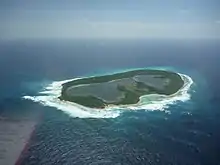
The vascular plant flora of the Cocos (Keeling) Islands consists of approximately 61 species native to the 22 vegetated islands and about 69 introduced species, most of which are confined to the two larger inhabited islands, Home Island and West Island. There are no plant species endemic to the islands; however, one variety of Pandanus tectorius, P. tectorius var. cocosensis,[1] is only found growing on these islands. The native vegetation of the two atolls primarily consists of sea-dispersed shoreline plants of the Indo-Pacific region. On the lagoon shoreline, tall shrublands are dominated by Pemphis acidula and Cordia subcordata, often growing in monospecific stands. Closed forest stands are dominated by either Cocos nucifera or Pisonia grandis.[2]
Much of the area of the southern islands has been modified for coconut plantations, altering the vegetation from the pre-settlement era. North Keeling, about 25 kilometres (16 mi) to the north, has been protected as part of the Pulu Keeling National Park, where 31 plants can be found, of which six are introduced. About half of the species on the southern atoll are introduced.[2][3]
In a report to Parks Australia in 2002, of the many introduced species on the southern atoll, Chromolaena odorata (Siam weed) was identified as being the greatest threat to the environment.[3] Most of the introduced species are pantropical herbaceous plants likely introduced to the southern atoll after the airfield was built in 1944.[2]
History
The Cocos (Keeling) Islands are isolated, being the only atolls in the eastern Indian Ocean, and were uninhabited until relatively recently in the early 19th century. The first botanical study was done while naturalist Charles Darwin visited the southern atoll for ten days, arriving April 1, 1836. Darwin collected 21 species during his time on the islands.[2]
In such a loose, dry, stony soil, nothing but the climate of the intertropical regions could produce a vigorous vegetation. Besides the Cocoa nut which is so numerous as at first to appear the only tree, there are five or six other kinds. One called the Cabbage tree, grows to a great bulk in proportion to its height, & has an irregular figure; its wood being very soft. Besides these trees the number of native plants is exceedingly limited; I suppose it does not exceed a dozen. Yet the woods, from the dead branches of the trees, & the arms of the Cocoa nuts is a thick jungle.
Later, the Scottish botanist Henry Ogg Forbes botanised the southern islands in 1879, collecting 38 species in 22 days, followed by W. E. Birch in 1885 and the British botanist Henry B. Guppy, who spent ten weeks in 1888 on both atolls. By far the longest visit by a naturalist was that of Frederic Wood Jones who spent 15 months on the southern atoll in 1909 and published his account in the book, Coral and Atolls. A History and Description of the Keeling-Cocos Islands, with an account of their Fauna and Flora, and a Discussion of the Method of Development and Transformation of Coral Structures in General, published in 1912. The northern atoll was visited in 1941 by the British naturalist Carl Alexander Gibson-Hill, who provided the first systematic assessment of the plant communities and a description of the dominant flora. The 1980s saw the two largest surveys in 1985 by I. R. Telford, who collected 93 species from both atolls, and in 1986-1987 by D. G. Williams, who collected 130 from all islands.[2]
Species
| Species | Family | Vernacular name | Local name | Status | Image |
|---|---|---|---|---|---|
| Dicliptera ciliata | Acanthaceae | native | |||
| Sesuvium portulacastrum | Aizoaceae | sea purslane | native |  | |
| Achyranthes aspera var. villosior | Amaranthaceae | chaff flower | native | 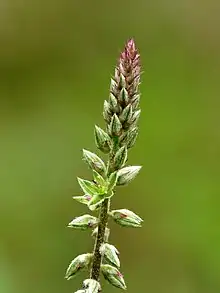 | |
| Aerva lanata | Amaranthaceae | introduced |  | ||
| Crinum asiaticum | Amaryllidaceae | crinum lily | native | .jpg.webp) | |
| Zephyranthes rosea | Amaryllidaceae | introduced | 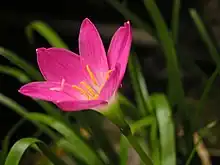 | ||
| Ochrosia oppositifolia | Apocynaceae | Kayu Laki | native | ||
| Cocos nucifera | Arecaceae | coconut | Kelapa | native |  |
| Austroeupatorium inulaefolium | Asteraceae | stinkweed | introduced | ||
| Chromolaena odorata | Asteraceae | Siam weed | introduced | 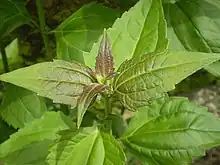 | |
| Cyanthillium cinereum | Asteraceae | introduced | 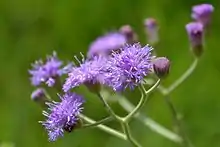 | ||
| Eleutheranthera ruderalis | Asteraceae | introduced | |||
| Emilia sonchifolia | Asteraceae | introduced | 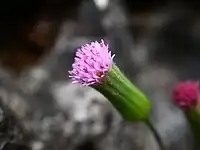 | ||
| Erigeron bonariensis | Asteraceae | fleabane | introduced |  | |
| Melanthera biflora | Asteraceae | beach sunflower | native | 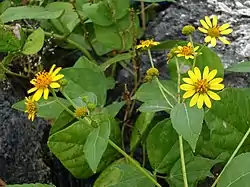 | |
| Sonchus oleraceus | Asteraceae | milk thistle | introduced |  | |
| Synedrella nodiflora | Asteraceae | introduced | 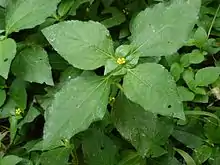 | ||
| Tridax procumbens | Asteraceae | introduced | _in_Hyderabad%252C_AP_W_IMG_7087.jpg.webp) | ||
| Argusia argentea | Boraginaceae | octopus bush | Kayu Sireh | native |  |
| Cordia subcordata | Boraginaceae | sea trumpet | Geronggang | native |  |
| Lepidium virginicum | Brassicaceae | introduced |  | ||
| Caesalpinia bonduc | Caesalpiniaceae | nickernut | Kelenchi | native | 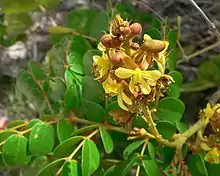 |
| Senna occidentalis | Caesalpiniaceae | introduced |  | ||
| Calophyllum inophyllum | Calophyllaceae | Alexandrian laurel | Nyamplong | native |  |
| Hippobroma longiflora | Campanulaceae | introduced |  | ||
| Carica papaya | Caricaceae | pawpaw | Katis | introduced |  |
| Casuarina equisetifolia subsp. equisetifolia | Casuarinaceae | coastal sheoak | Cemara | native | 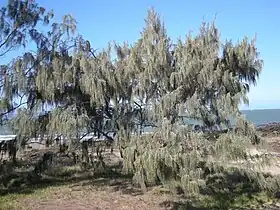 |
| Cleome gynandra | Cleomaceae | native | 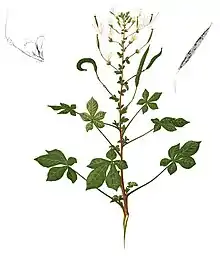 | ||
| Terminalia catappa | Combretaceae | sea almond | Ketapang | native | .jpg.webp) |
| Tradescantia spathacea | Commelinaceae | introduced | _Vittata_Mayflower_Faminly_(3073341052).jpg.webp) | ||
| Ipomoea violacea | Convolvulaceae | moon flower | native | 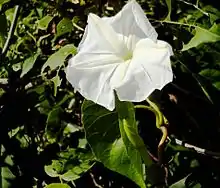 | |
| Ipomoea pes-caprae | Convolvulaceae | goat's-foot | Kangkong Meryap | native | 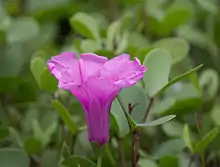 |
| Bryophyllum pinnatum | Crassulaceae | introduced | 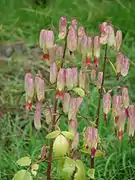 | ||
| Syringodium isoetifolium | Cymodoceaceae | sea grass | native | 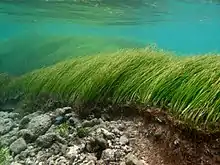 | |
| Thalassodendron ciliatum | Cymodoceaceae | sea grass | native | ||
| Cyperus bulbosus | Cyperaceae | nut grass | native | ||
| Cyperus javanicus | Cyperaceae | native |  | ||
| Cyperus polystachyos | Cyperaceae | introduced | 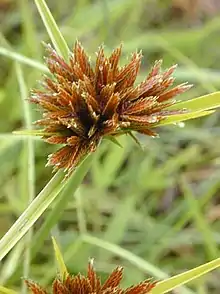 | ||
| Fimbristylis cymosa | Cyperaceae | native |  | ||
| Queenslandiella hyalina | Cyperaceae | native | |||
| Acalypha indica | Euphorbiaceae | native |  | ||
| Acalypha lanceolata | Euphorbiaceae | native | |||
| Euphorbia atoto | Euphorbiaceae | native | |||
| Euphorbia cyathophora | Euphorbiaceae | dwarf poinsettia | introduced | 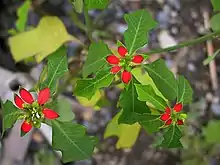 | |
| Euphorbia hirta | Euphorbiaceae | introduced | 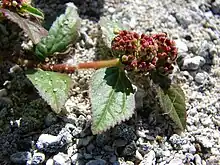 | ||
| Euphorbia prostrata | Euphorbiaceae | introduced | 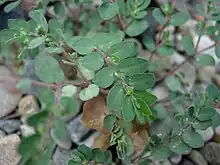 | ||
| Ricinus communis | Euphorbiaceae | castor oil plant | Pokok Jaru Jarak | introduced | 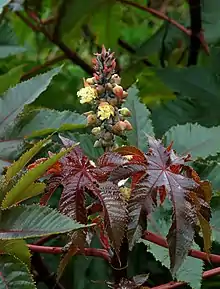 |
| Alysicarpus vaginalis | Fabaceae | introduced | 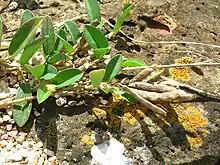 | ||
| Canavalia cathartica | Fabaceae | sea bean | native | 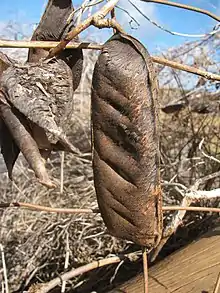 | |
| Crotalaria retusa | Fabaceae | introduced | _Chain_of_Craters_Road_Hawaii_Volcanoes_National_Park_Hawaii.jpg.webp) | ||
| Desmodium triflorum | Fabaceae | introduced | 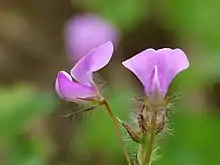 | ||
| Erythrina variegata | Fabaceae | coral tree | Kayu Dedap | native | 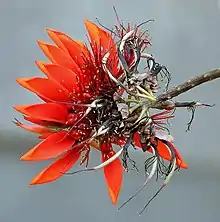 |
| Indigofera hirsuta | Fabaceae | introduced | _(6372953579).jpg.webp) | ||
| Leucaena leucocephala | Fabaceae | leucaena | Peteh | introduced |  |
| Macroptilium atropurpureum | Fabaceae | siratro | introduced | 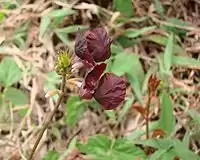 | |
| Sesbania cannabina | Fabaceae | introduced |  | ||
| Sesbania grandiflora | Fabaceae | Turi | introduced |  | |
| Vigna marina | Fabaceae | native | _-_02.jpg.webp) | ||
| Enicostema axillare subsp. littorale | Gentianaceae | native | |||
| Scaevola taccada | Goodeniaceae | sea lettuce | Kayu Kankong | native | .jpg.webp) |
| Hernandia nymphaeifolia | Hernandiaceae | sea hearse | Kayu Jambu Hutan | native | 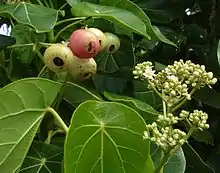 |
| Thalassia hemprichii | Hydrocharitaceae | sea grass | native | ||
| Clerodendrum indicum | Lamiaceae | introduced |  | ||
| Vitex trifolia | Lamiaceae | native | 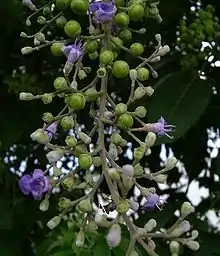 | ||
| Volkameria inermis | Lamiaceae | sorcerer's flower | native | 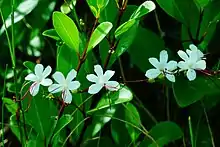 | |
| Cassytha filiformis | Lauraceae | devil's twine | native | 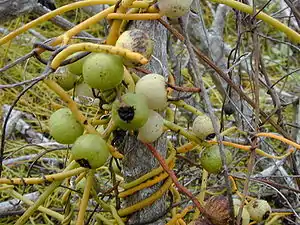 | |
| Barringtonia asiatica | Lecythidaceae | box fruit | Kayu Besagi | native | .jpg.webp) |
| Pemphis acidula | Lythraceae | Kayu Keriting | native | 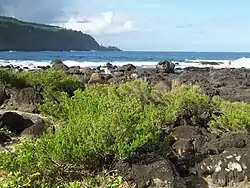 | |
| Hibiscus tiliaceus | Malvaceae | cotton tree | Pokok Waru | native | 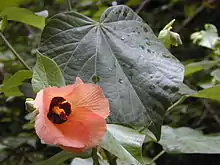 |
| Sida acuta | Malvaceae | introduced | _in_Hyderabad%252C_AP_W2_IMG_0084.jpg.webp) | ||
| Thespesia populnea | Malvaceae | portia tree | Waru Hutan | native | 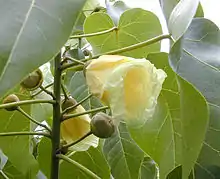 |
| Triumfetta repens | Malvaceae | Bingit burr | native | ||
| Muntingia calabura | Muntingiaceae | Buah Cheri | introduced | _in_Hyderabad%252C_AP_W_IMG_9597.jpg.webp) | |
| Eugenia sp. | Myrtaceae | Jambu Ayer | introduced | ||
| Psidium guajava | Myrtaceae | guava | Jambu Biji | introduced |  |
| Boerhavia albiflora | Nyctaginaceae | introduced | |||
| Boerhavia diffusa | Nyctaginaceae | introduced | 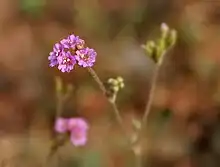 | ||
| Boerhavia repens | Nyctaginaceae | native |  | ||
| Pisonia grandis | Nyctaginaceae | pisonia | Ampol | native | 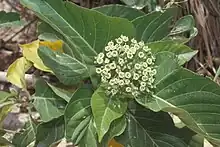 |
| Ximenia americana | Olacaceae | yellow plum | Rukam | native |  |
| Striga angustifolia | Orobanchaceae | introduced |  | ||
| Pandanus tectorius var. cocosensis | Pandanaceae | screw palm | Pandan | native | |
| Passiflora foetida var. hispida | Passifloraceae | stinking passionflower | introduced | 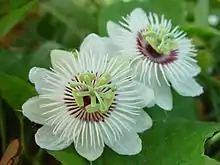 | |
| Turnera ulmifolia | Passifloraceae | introduced |  | ||
| Breynia disticha | Phyllanthaceae | introduced |  | ||
| Phyllanthus amarus | Phyllanthaceae | native | |||
| Sauropus androgynus | Phyllanthaceae | Keretu | introduced | 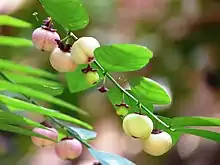 | |
| Rivina humilis | Phytolaccaceae | coral berry | introduced | .jpg.webp) | |
| Scoparia dulcis | Plantaginaceae | introduced | 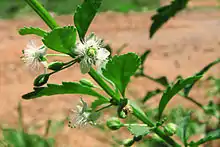 | ||
| Apluda mutica | Poaceae | introduced |  | ||
| Bothriochloa bladhii | Poaceae | introduced | 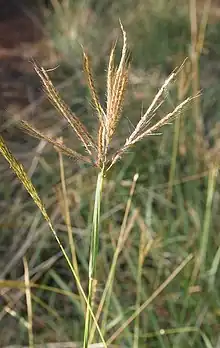 | ||
| Brachiaria brizantha | Poaceae | introduced | |||
| Cenchrus ciliaris | Poaceae | introduced | 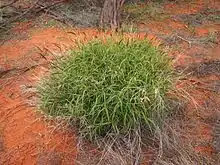 | ||
| Cenchrus echinatus | Poaceae | sand burr | introduced | 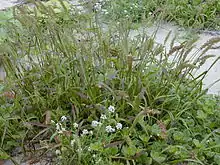 | |
| Chloris barbata | Poaceae | introduced |  | ||
| Chrysopogon aciculatus | Poaceae | introduced | 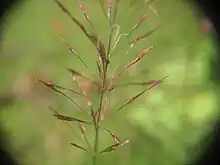 | ||
| Cynodon dactylon | Poaceae | couch grass | introduced |  | |
| Cynodon radiatus | Poaceae | introduced | |||
| Dactyloctenium aegyptium | Poaceae | introduced | 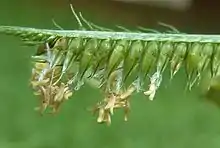 | ||
| Desmostachya bipinnata | Poaceae | introduced | |||
| Digitaria setigera | Poaceae | introduced | |||
| Eleusine indica | Poaceae | crowsfoot grass | introduced |  | |
| Eragrostis amabilis | Poaceae | introduced |  | ||
| Eriochloa meyeriana | Poaceae | introduced | |||
| Imperata cylindrica var. major | Poaceae | bladey grass | introduced | ||
| Ischaemum muticum | Poaceae | introduced | |||
| Lepturopetium sp. aff. marshallense | Poaceae | native | |||
| Lepturus repens | Poaceae | stalky grass | native | 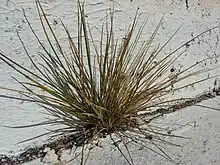 | |
| Panicum repens | Poaceae | introduced | 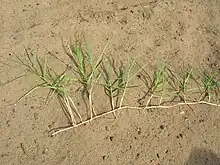 | ||
| Paspalum vaginatum | Poaceae | native |  | ||
| Sporobolus fertilis | Poaceae | sand couch grass | introduced | 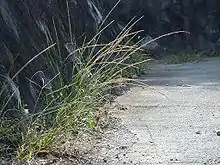 | |
| Stenotaphrum micranthum | Poaceae | beach buffalo grass | native | ||
| Thuarea involuta | Poaceae | bird's-beak grass | native | 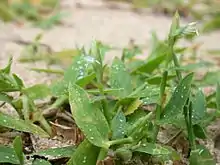 | |
| Zoysia matrella | Poaceae | native | 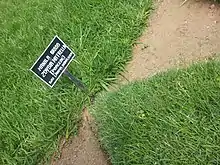 | ||
| Unidentified sp. | Poaceae | introduced | |||
| Portulaca oleracea | Portulacaceae | pigweed | native |  | |
| Rhizophora apiculata | Rhizophoraceae | spider mangrove | native | ||
| Guettarda speciosa | Rubiaceae | Kembang Melati Hutan | native | 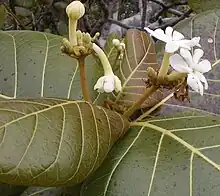 | |
| Morinda citrifolia | Rubiaceae | cheesefruit | Mengkudu | native | .jpg.webp) |
| Oldenlandia corymbosa | Rubiaceae | introduced | .jpg.webp) | ||
| Spermacoce remota | Rubiaceae | introduced | 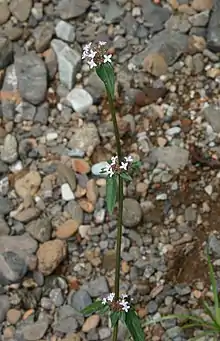 | ||
| Triphasia trifolia | Rutaceae | Buah Kengkit | introduced | 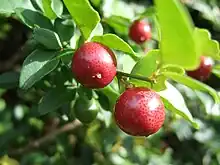 | |
| Allophylus cobbe | Sapindaceae | native |  | ||
| Dodonaea viscosa | Sapindaceae | hopbush | native | _W2_IMG_1899.jpg.webp) | |
| Physalis minima | Solanaceae | Chepelok | introduced |  | |
| Solanum americanum | Solanaceae | blackberry nightshade | introduced | 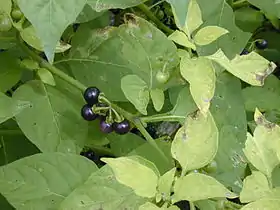 | |
| Suriana maritima | Surianaceae | native | .jpg.webp) | ||
| Laportea aestuans | Urticaceae | native | |||
| Phyla nodiflora | Verbenaceae | introduced | .JPG.webp) | ||
| Premna serratifolia | Verbenaceae | native |  | ||
| Stachytarpheta jamaicensis | Verbenaceae | blue snakeweed | introduced |  |
See also
References
- ↑ Flora of Australia, Vol. 50, Oceanic Islands 2. 1993. p. 7.
- 1 2 3 4 5 Williams, D.G. 1994. Vegetation and flora of the Cocos (Keeling) Islands. Atoll Research Bulletin, 404: 1-29.
- 1 2 Claussen, J., and D. Slip. 2002. The status of exotic plants on the Cocos (Keeling) Islands, Indian Ocean. Parks Australia North, Department of the Environment. Accessed online: 13 May 2015.
- ↑ Keynes, Richard. 2001. Charles Darwin's Beagle Diary. Cambridge University Press. pp. 414–415.
External links
- Flora of Pulu Keeling National Park. Department of the Environment, Australian Government.